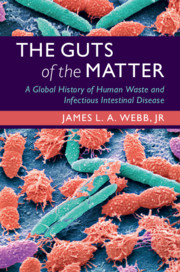Book contents
- The Guts of the Matter
- Studies in Environment and History
- The Guts of the Matter
- Copyright page
- Dedication
- Contents
- Figures
- Acknowledgments
- Introduction
- 1 Pathogens and Parasites
- 2 Early Change
- 3 Diffusion and Amplification
- 4 Innovations
- 5 Adoptions and Adaptations
- 6 The Struggle against Hookworm Disease
- 7 An Era of Optimism
- 8 Global Health and Infectious Intestinal Disease
- Conclusion
- Bibliography
- Index
2 - Early Change
Published online by Cambridge University Press: 18 November 2019
- The Guts of the Matter
- Studies in Environment and History
- The Guts of the Matter
- Copyright page
- Dedication
- Contents
- Figures
- Acknowledgments
- Introduction
- 1 Pathogens and Parasites
- 2 Early Change
- 3 Diffusion and Amplification
- 4 Innovations
- 5 Adoptions and Adaptations
- 6 The Struggle against Hookworm Disease
- 7 An Era of Optimism
- 8 Global Health and Infectious Intestinal Disease
- Conclusion
- Bibliography
- Index
Summary
The second chapter, “Early Change,” explores what is known about environments in which intestinal disease transmission emerged. It marshals research in the biological sciences to discuss the settings in which early communities were able to transmit some intestinal pathogens and parasites, long before the agricultural revolution. It suggests that the construct of the “first epidemiological transition” needs to be revised. It explores the patterns of vulnerability to infectious intestinal disease associated with hunting, gathering, and fishing in an early era and those associated with early farming practices, settlements, and pastoral nomadism. It provides a historical overview of the evolution of zones of infectious intestinal disease, the various Eurasian attitudes toward human waste, regional patterns in the use or non-use of human excreta in early agriculture, and early urban sanitation.
Keywords
- Type
- Chapter
- Information
- The Guts of the MatterA Global History of Human Waste and Infectious Intestinal Disease, pp. 24 - 41Publisher: Cambridge University PressPrint publication year: 2019

